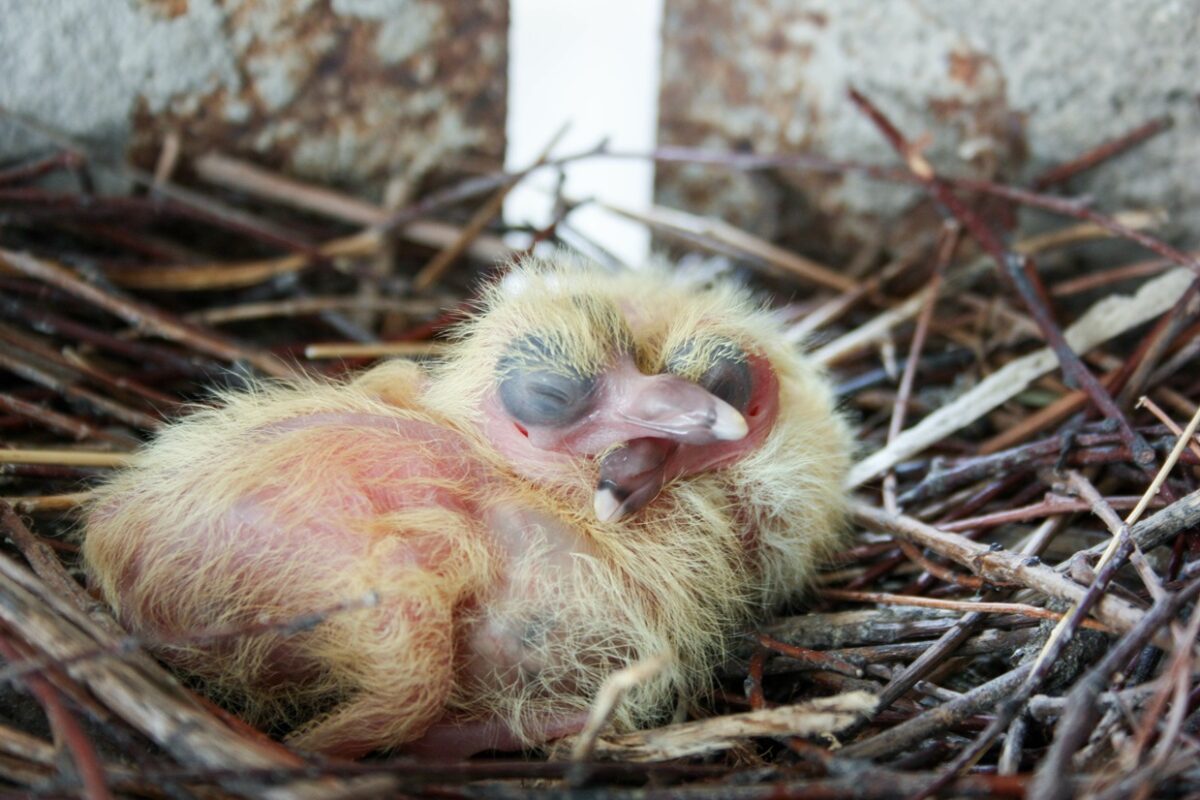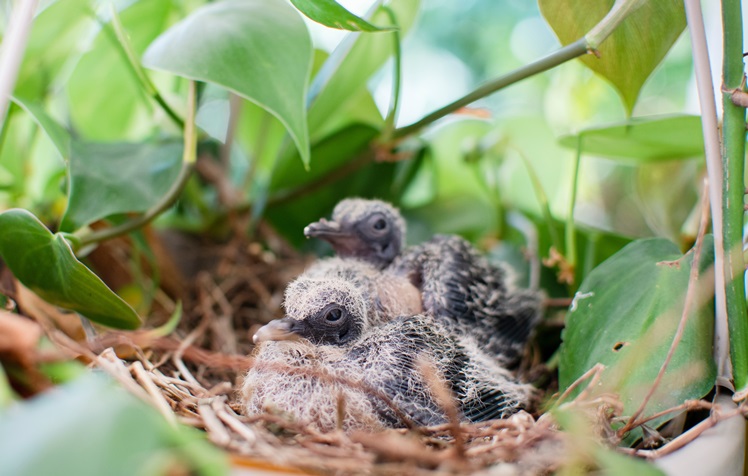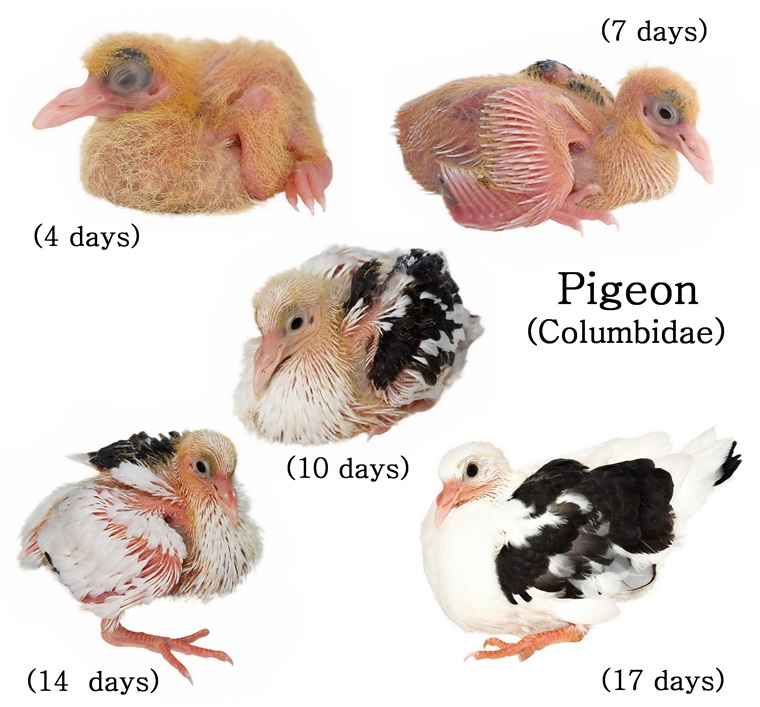There are actually some 300 species of the family Columbidae which includes both pigeons and doves. The pigeons included in this classification contain those as beautiful and ornate as the Jacobin breed prized by Queen Victoria or those bred for flight characteristics such as the easily recognizable Homing Pigeon, descended from the Rock Pigeon.
When one thinks of pigeons, the first image that jumps to mind may be that of Columba livia, the Rock Pigeon. The Rock Pigeon’s range stretches to every continent except Antarctica. An old descendant of escaped domestic pigeons, Rock Pigeons (also called feral pigeons) became wild in North America some 400 years ago. Other Old World feral populations are thought to be thousands of years old.
Despite their reputation, pigeons are far from a nuisance – in fact, domestic pigeons have been around for some 4000 years and probably longer. People find pigeons bothersome when they intrude into our human spaces, but really, they do little harm, if any.
Pigeons are quite intelligent, with strong navigational and visual skills. In one fascinating study, pigeons were even shown to discriminate between the paintings of Monet and Picasso. In many places that pigeons inhabit, they are considered a pest, but anyone who has sighted a fluff-covered baby pigeon will quickly disagree.

Where are all the baby pigeons?
Few have seen a baby pigeon in person, leading many to wonder where the young of these common birds actually are.
What are baby pigeons called?
A baby pigeon is known as a squab. Similarly, a slightly more mature baby pigeon that is yet to develop the ability to coo is sometimes called a squeaker, although this term is considered informal.
Where to find baby pigeons?
Because baby pigeons rely on their parents for care longer than some other birds, they are seldom seen outside of the nest, unless they have fallen. Pigeon hatchlings rely on their parents for a good month before flying or feeding themselves – therefore baby pigeons must stay in the nest to survive.
Urban pigeons tend to nest in the nooks and crannies of buildings and other manmade structures like bridges. They nest often on balconies, beneath eaves and overhangs, and in stairwells. Other species of pigeon may nest in cliffs or ledges in the natural environment. Woodpigeons (Columba palumbus) tend to nest in denser foliage like trees and hedgerows, although they may choose buildings as well if they find them accessible.
Ever wonder why you never see baby pigeons? Once the birds do fledge, they have adopted much of their adult plumage and are difficult to differentiate from full-grown pigeons.
Can you touch baby pigeons?
Is it OK to pick up a baby pigeon? The short answer is no, not unless you have to. Baby pigeons are best left with their parents – if you touch them you risk the parent rejecting them and leaving the hatchlings to die. Unless a baby pigeon has fallen out of the nest, you should not move or touch it.
Can you move baby pigeons?
Hatchlings can be loud and persistent. The wish to move them or their nest is an understandable one – however, doing so will result in the parents abandoning the nest. Luckily, baby pigeons will only stick around for about a month, so the wait for their departure should be short.
When do baby pigeons start to fly?
For most breeds, baby pigeons are able to leave the nest in 26 – 30 days. Once adults, some common breeds can weigh around 500 grams, with some species weighing up to 600 grams, multiplying their initial hatchling weight by about 30 to 40 times. The weight of certain wild breeds may be less.

What does a newly hatched pigeon look like?
Wondering if you’ve found a baby pigeon? Here’s what the most common baby pigeons look like in the first 30 days of life.
What do baby pigeons look like?
Most babies weigh around 15 grams at hatching. Like many hatchlings, baby pigeons have a wooly, gangly look. Freshly hatched Rock Pigeons will have a fuzzy, yellow appearance, with this patchy fluff covering their pinkish or dark skin. Their beak is pink, long, and flat and their gray feet are large in proportion to the rest of their body.
As they mature over the next 4 weeks, their adult feathers will grow in and they’ll slowly lose their downy, yellow fluff. They will look nearly identical to their parents by the time they are ready to leave the nest.
What do baby pigeons sound like?
Anyone who’s had pigeons nesting outside their window knows these youngsters are far from quiet. Baby pigeons emit a soft squeaking sound that gets louder when they anticipate food.
As noted in an excerpt from A Pocket Guide to Pigeon Watching: Getting to Know the World’s Most Misunderstood Bird, unlike their parents who emit deeper, more easily recognized coos, baby pigeons can’t produce this sound yet and won’t be able to for 7 to 8 weeks. Instead, they emit squeaks or wheezy whistles to call for food.

When do baby pigeons leave the nest?
Over the course of a month, baby pigeons will develop from small, vulnerable hatchlings to birds that look almost indistinguishable from their parents, save a few sparse remnants of fluff.
When are baby pigeons born?
Peak breeding season is in spring and summer although urban pigeons may breed year-round. Some pigeons will even lay a second set of eggs before the squabs have left the nest when the babies are just two weeks old.
The Carrier breed is one such pigeon that reproduces again quickly, preparing its nest for yet another brood as their fledglings leave. A pair of Rock Pigeons may raise 5 broods or more every year.
When do baby pigeons hatch?
Baby pigeons hatch in about 17 to 18 days. The eggs are small, white, and most often occur in pairs. Oftentimes a hen (female pigeon) will lay one egg first, followed by a second egg 1 to 2 days later. This being so, the first laid egg may hatch on the 18th or 19th day.
When do baby pigeons fledge?
Baby pigeons begin to fly or fledge about four weeks after hatching. On average this takes 26 to 30 days.

When can baby pigeons feed themselves?
Baby pigeons rely entirely on their parents for the first 4 weeks of their lives. Their parents supply them with food and nourishment until they are able to fledge and source it on their own.
What do baby pigeons eat?
Squabs are fed “pigeon milk” or “crop milk” by their parents. Pigeon milk is a high-protein fluid secreted by the parents, looking somewhat like custard or cottage cheese.
For those who don’t know, the crop is a part of the esophagus used for storing food before digestion. Both pigeon parents will begin making pigeon milk a few days before the eggs hatch. They’ll then feed this substance to their hatchlings for the next 10 days. Not all birds have a crop, but pigeons are one such species that does.
When do baby pigeons start eating on their own?
Baby pigeons are altricial, meaning they rely completely on their parents for care and food. Unlike precocial birds who are born with the ability to see and walk, altricial birds are born blind and undeveloped. These vulnerable hatchlings must remain with their parents for 6 weeks before becoming independent and being able to feed and drink on their own.
In Carrier breeds, during the first phase of feeding (about 8 days after hatching), the young are fed only pigeon milk. In the second phase (9 to 20 days) the chicks experienced enhanced feeding with a mixture of food that is disgorged by the parents – this period marks the fastest rate of growth of the hatchlings. After this is the third phase (21 days onward), where the food is slowly decreased by the parents.
Adult rock pigeons feed on seeds, waste grain, and occasionally berries, acorns, and insects. In cities, they feed largely on food scraps.
If a baby pigeon is rejected or separated from its parents, it is possible to hand-feed baby pigeons once they are one week old using a pigeon grain ration soaked in water. However, it is best to try and find the nest and replace the bird there.
